 |
"Santa Cruz
Powder Mill"
|
|
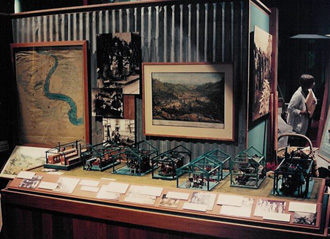
The completed exhibit features the enhanced diorama.
|
|
| |
|
|
1993 -- the Santa Cruz, CA McPherson Center for Art
& History
Size:
30" x 72"
Scale: 1/2" = 1 ft. (1/24th scale)
Figures: 4 at 3 in. tall
Features: Diorama using
see-through models of the machinery used in the 19th century powder mill,
demonstrating the process of making black powder. Figures added to indicate
diorama scale and to help viewers understand the size of the original
machinery.
|
|
| |
|
| |
|
|
The Problem: The McPherson Center for Art
& History had access to an historic (50-plus year old) lay-built demonstration
model depicting the various steps used at the Santa Cruz Powder Mill to
make black gun powder at the turn of the 20th century. It was designed
and built by a man who had worked at the mill for many years and took
on the project after he retired in the 1930s. Originally built as a working
model with leather belts, wooden pulleys and hand-carved cog wheels, the
model had fallen into disrepair and had been in storage for some years.
Belts were dried up and warped, wooden cog teeth were missing and many
of the detail items such as chutes, hoppers, etc. had come unglued or
lost parts. There was structural damage to some of the buildings and some
paint had chipped off. (Example at right.)
|
|

Before repairs, some model pieces were broken and scattered. |
|
| |
|
| The Challenge:
Working as a subcontractor to the South County Design Center, the exhibit
designers for the development of this new museum, we inventoried the model
for damage and any missing black powder manufacturing process elements,
as well as investigating the potential for making the model "work"
again - push the button and watch the machinery run. The overall goal was
to develop a dynamic exhibit about the powder mill as a piece of local history,
utilizing this model in a diorama that would serve as the centerpiece of
the exhibit. All, of course, within a limited budget. This required research
as to exactly how the process for producing black powder was done. |
|
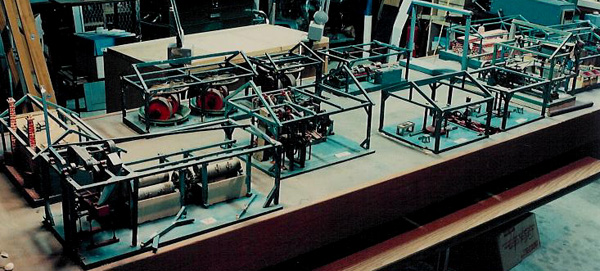
After being in storage for several years, the once interactive display proved
to be impractical to resurrect as a "working model". |
|
| |
|
| |
|
| |
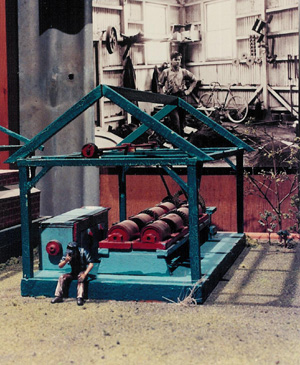
In the finished exhibit, the fixed up machinery sheds are enhanced by
the addition of landscaping and 24th scale (3" tall) workers (this
one mops his brow) as well as historical images and text panels which
combine to complete the story.
|
|
The Solution: The client accepted our recommendation
against any attempt to get the model to "work" as it was too
fragile and would be "down" too much. Instead, we removed the
process buildings from the original base, repaired the damage and touched
up the paint. We then reconfigured the arrangement of the process buildings,
lining them up in the order of each actual process step rather than the
original random placement of each process machine, the locations dictated
by the necessities of connecting each one to the series of pulleys and
belts from under the original base. In order to add some life to the scene
we provided a suggestion of landscaping - turf, bushes, a tree or two
- as well as some dynamic scale figures actively involved with the huge
processing machinery to give a sense of scale and energy. The finished
exhibit's presentation was enhanced
with historical photos of the process and explanatory
text to tell the story.
|
|
| |
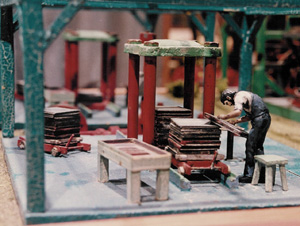 |
|
| |
|
| |
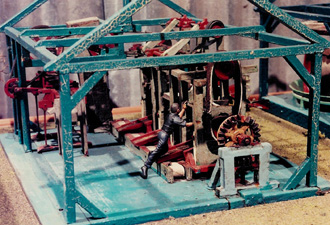
A worker checks the crushers before starting a new run of material. The
powder mill was only one of several types of mills that made use of the
hydro power of the Santa Cruz River.
|
|
A worker loads squares of pressed black powder onto a cart, then to be pressed
again. Explosions were common. The machine sheds were largely wood framed
with two flimsy sides that would easily blow off the framework when explosions
occurred, limiting both damage and injury. |
|
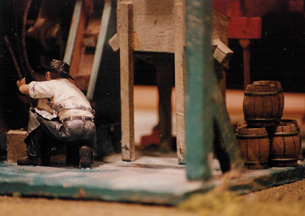
Machine tender's aprons were typically coated in a shiney layer of gun powder
dust, like graphite. Creating this figure's apron of thin lead foil successfully
represents the right shiney look, as well as promotes the appearance of
weight in the way it can be draped. |
|
| |
|
|
|
|
|
|
Website designed by Moments In Time Exhibits
Contact webmaster
with comments/questions.
|
|
|
|
|
|
|
|
|
|
|
|
|
|
|
|

